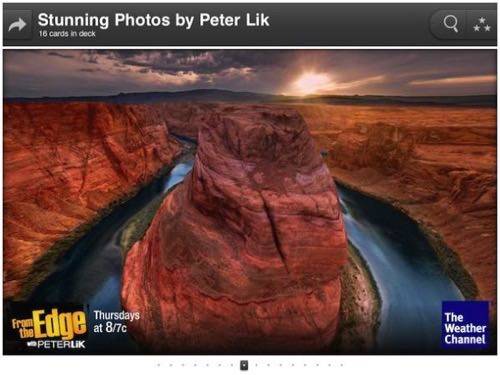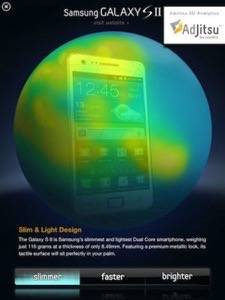Ads are as much a part of the Web as all that other stuff next to them, such as blog posts. We’ve gotten used to getting much (or all) of our online content for free, so we pay with our eyeballs instead. Advertisers pay publishers for little fragments of our attention on the off-chance that some of us will notice, be intrigued, click and hopefully buy something.

It’s a generalization to say that the realities of this market have driven the quality of Web experiences into the ground. But surely, you’ve noticed lots of annoying, flashing, animated ads bothering you to do something. Well, remember Cooliris? In October, we covered its first forays into 3D ads. Cooliris has a feeling we Web users would rather be delighted by ads than harassed. Sound too good to be true? Read on and see for yourself.
The First Draft

When we first met Cooliris, it was introducing its new ad unit, AdJitsu, which had just launched its first interactive, touch-controlled, 3D mobile ads.
One of the campaigns was for the Samsung Galaxy S II. Instead of a boring banner ad, consumers saw a phone jiggling around inside the banner in response to the accelerometers of their iPhones and iPads. When they tapped the ad, it opened up into a sort of app, in which they could zoom in and out on the product, manipulating it with familiar touchscreen gestures, in order to check it out.
It was neat. But was it revolutionary? Would the ability to play with a virtual model of a phone really convert any viewers into customers? Cooliris enlisted the help of some neuromarketers to make the case that AdJitsu ads were at least more interesting than passive videos, but the brain scans left us with more questions than answers. Sure, these ads are stimulating, but does that make them effective?
The Next Level
Well, Cooliris has been working on making the product speak for itself. What they showed me this time is not just better; it is bigger. There’s more to these new ads. You can explore them, experience them. You don’t need your brain scanned to find them enjoyable.
And there’s more AdJitsu news than just new ad campaigns. Before, AdJitsu was an in-house mobile ad unit. Now, it’s a platform, and it goes beyond mobile devices. Using Web technology and developer-friendly tools, now any advertiser can make ads that don’t suck.
Setting The Ad World On Fire
“Our goal was to take the world of display advertising and set it on fire,” says AdJitsu product manager Aneesh Karve. He says that ads today don’t take advantage of the capabilities of today’s hardware. AdJitsu isn’t even stopping there; it is building an ad platform for devices one or two years down the road using next-generation graphics library WebGL. When phones get WebGL support and smoking-fast GPUs, AdJitsu will be ready for them.
The 3D models come from a variety of places. Some advertisers, like video game makers, already have 3D models ready to go. Other manufacturing companies, whether they make cars or phones, have engineering models at the ready that AdJitsu can simplify and prepare for the Web. Other ads use commercially available models or data, and some advertisers even spring for custom models. To bring those models to life in an interactive ad, AdJitsu has built versatile tools and a powerful engine.
The AdJitsu Engine
Currently, Apple doesn’t allow third-party advertisers to use WebGL, even though the mobile Safari browser supports it. The only ads allowed to use WebGL on iOS are Apple’s own iAds. Apple claims that this is because of security holes. Karve notes that it also lets Apple get a head start in 3D advertising on its platform. Either way, AdJitsu ads still run natively on iOS devices, and you build them with AdJitsu’s software development kit.
But for other devices, PCs, tablets and phones alike, the engine uses WebGL. The performance isn’t quite there yet on most Android phones, but it runs, and Cooliris is thinking ahead to next year’s phones, anyway. AdJitsu has built upon the Web and cutting-edge hardware to enable silky-smooth, immersive 3D ads that run anywhere, and that anyone can build.
The Tools: Do Your Own AdJitsu
AdJitsu’s tool is called PageKit. Developers can write an ad once and run it everywhere. PageKit even makes it easier for developers used to writing 2D code. It bridges the gap to 3D for them, so they don’t have to start over again and learn OpenGL, which Karve points out has a “pretty heady API.” You write in PageKit’s markup, and it all compiles down to the native iOS engine and the WebGL engine.
Need more perspective on that? Allow me to introduce Max. He’s 13. In this less-than-three-minute video, you can watch him build an AdJitsu ad in “62 or so” lines of code. Don’t worry, non-geeks; he explains the process amazingly well.
The Kicker: Better Analytics
For those still looking for a traditional “value-add” for these 3D ads, you don’t have to scrutinize an inscrutable brain scan this time. Cooliris has gone with something more easily measured.

Since users interact so extensively with these 3D models, AdJitsu ads can record heatmaps of which parts of the experience are most interesting to consumers. That’s valuable feedback for advertisers and product people, who can use it to figure out what kinds of features to emphasize. Can your average banner ad do that?
Ads That Don’t Suck
Instead of racing to the bottom with garish display ads, Cooliris has posed a challenge to the advertising world. With all this potential at our disposal, why do ads suck so much? They don’t have to. AdJitsu has proven they can be fascinating, beguiling, even beautiful.
What will we do when the ads are better than the stuff we’re putting next to them? I know what I’ll do: I’ll try to make even better stuff. Thus far, Web ads have been a race to the bottom. Hats off to Cooliris for raising the bar for all Web experiences, not just for ads.
What do you think of these ads? Would you play with one?










